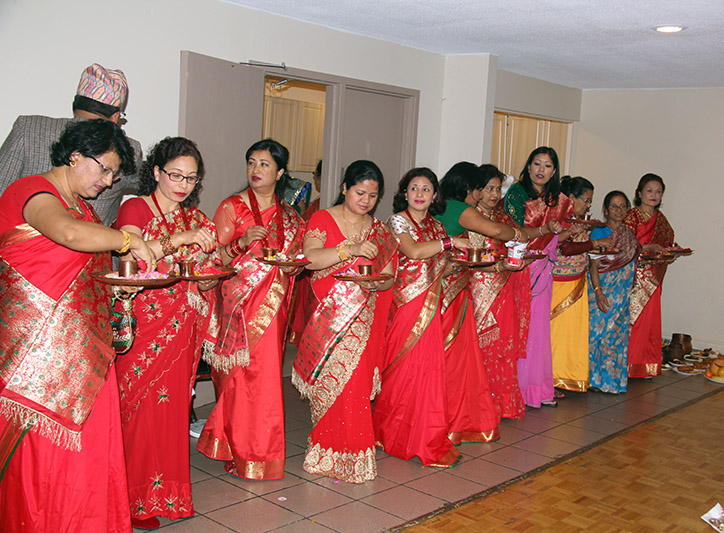
Worshipping Own’ Body: A Unique Culture of Newars
-Uttam Makaju
Once Lord Krishna, the incarnation of Lord Vishnu, asked the people of Mathura” Why are you keen to worship God? Worship yourself first and know yourself. Without knowing yourself you can not be perfect human being.” This saying of Lord Krishna seems very meaningful in these days. Because many people in the world are loosing their entity in the name of modernism and materialism. Body is the source of energy to learn and think. Some of Hindu mythologies undermine body factors. But Newars, an ethnic group of Nepal, have unique culture of worshiping own body, which is called “Mhapuja.” Newar people believe that one needs to understand and respect oneself before you understand others. “Mhapuja” is a cultural event of purification, strengthening and understanding oneself. It exposes a relationship of person with surrounding nature and the cosmos. Understanding one’s role in life makes him/her more knowledgeable and selflessness enriches oneself by itself leading towards prosperity and physical well-being in the line with socio-religious nature. Hindu religion believes that soul or inner self never dies. Only the body, which the soul uses as a vehicle, dies. Soul gets to born in bodily form (like human, animal, plant etc) according to their past deeds. Human life is considered the best among the life cycle. The worship of divinity in oneself perfectly matches with philosophy of life.
Historians believe that the ritual of “Mhapuja” started over a thousand years ago. From time immemorial, this day has been taken as auspicious and important day. The celebration of “Mhapuja” was started even before the starting of Nepal Era. But, Mr. Sankhadhar Sakhawa, who contributed in initiating Nepal Era, chose this auspicious day to start the calendar.
“Mhapuja” is performed on the floor in the evening on specific day of lunar calendar. Procedures may vary from family to family but basics are same. Mandala, an artistic geometrical circle drawn with special materials, is the essential part of the celebration. It is created on the floor in front row of seats for the family members. It is believed that Mandala represents human self. Circles are drawn in Mandala. “Mhapuja” stresses on strong, long lasting, healthy, fragrant with positive connotation.
The circles in Mandala signify completeness in the life. Beautiful artistic geometric shape of Mandala is created for the celebration. On the outside is large ring enclosing smaller one within which the squares are overlapped to find eight triangular shapes. Each Mandala is created by following specific procedure. A set of closely spaced concentric are first drawn in each Mandala employing mustard oil soaked clothe piece wrapped around flower plant. Oil marks last longer just as oil strand of strings burns longer.A handful of paddy and rice mixture is placed on each of four triangular shapes and center of the Mandala.
The worship begins same as worshiping God. The main function takes place in the evening. The family members sit cross-legged in a row. Besides family members, rooster, broom, bamboo tray, water pot and stone grinder are also worshiped as living entities. Every body worships own Mandala.The eldest female in the family leads the whole process of the worship. It reflects the higher role of female in Newar Community. She worships the home God first before starting the process.Lighting of incense stick pleases the soul and hopefully, makes the persons life successful and fragrant.
Another important part is offering of light. Two hand woven cotton strands soaked in oil are lighted at each end and offered to the person. The light is accepted to enhance one’s inner supreme brightness and to drive away any possible problems. The lights are placed on the Mandala covering four corners by each end of string. The light is kept burning through out the “Mhapuja” celebration. It is worth mentioning that light is one of the five elements used to create universe.
Sagan, offering of egg, meat, fish in one hand and liquor in another hand, reflects extra ordinary and meaningful achievement.The egg, meat and fish symbolize victory and control over animal beings living in cell, water and land. However, liquor depicts the great celebration.Before sagan, Dhau Sagan, a mixture of yogurt, rice and vermilion powder is offered on forehead of each member. It reflects the cheerful and festive ambiance of the celebration.
Flowers are another integral part of “Mhapuja” celebration. It blends the event into fragrance and cheerfulness. A special species of flower garland namely Makhamali, is worn around the neck for long lasting and successful life. It is noteworthy that Makhamali flower never fades. This may be the reason that they chose symbolizing long lasting life. Jajanka, a white round cotton threads of many rounds forming a circles with small piece of red clothe, is also worn on neck like garland. Jajanka symbolizes the beginning with the end. It is also a connotation of creation, maintenance and fullness of the life.
Next comes the offering of fruits and sweets. Offering of different fruits and sweets symbolizes resourcefulness and vividity in life. Items like walnut, chest nut and coconut depicts that they seem very hard and tough but tender and delicate inside. It reflects the philosophy of life. Fruits like lime, grapefruit, sugarcane and moon and star shape sweets also reflect different situation in our life. Some time we have very favorable situation like the taste of sugarcane and sometime we encounter unexpected situation like a lime. But still we have to bear it. It is the ground reality of our life. Moreover, it shows the relationship with nature and cosmos.
The final ritual of the celebration is purification of soul and blessing from the eldest female by showering a mixture of flower, small pieces of fruits, vermilion powder and popped rice on head. Till this time, the cotton thread light on the Mandala should keep burning which makes the event cheerful, illuminated and fragrant. The event comes to end when the performer drags broom from home God’s Mandala to all the way down to last Mandala followed by typical Newari feast.
In Greater Toronto Area, the “Mhapuja” has been celebrating publicly since last nine years during Deewali festival by Canadian Newa Guthi (www.canadiannewaguthi.org) , a GTA based not for profit organization dedicated to share diverse culture and serving newcomers and immigrants in disseminating information and creating awareness on health. For the year 2013, ‘Mhapuja celebration is scheduled to observe on Sunday, November 03, in Brampton.
On reviewing the whole process of “Mhapuja”, one can learn that how important to know yourself before doing anything to the community, society , and the world. As the apostle of peace Gautam Buddha preaches that if you want to give light to others, you should be capable to provide light. Unless you are not capable, you will not be successful in your goal. For example, the candle burns itself to provide light to others. At the same time, there can be lots of high and low in the life. But we should not go away from the problem. Rather, know yourself; upgrade your skill as per needs, face the situation, get success and feel contended. This can be a message of “Mhapuja”, a unique culture of Newars.





